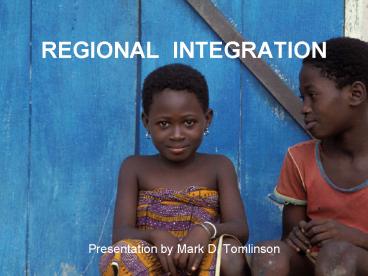REGIONAL INTEGRATION - PowerPoint PPT Presentation
1 / 19
Title:
REGIONAL INTEGRATION
Description:
Infrastructure over median land area equivalent to France? SQUARE MILES POPULATION (2004) ... Examples: West Africa Gas Pipeline, WA Power Pool, ... – PowerPoint PPT presentation
Number of Views:15
Avg rating:3.0/5.0
Title: REGIONAL INTEGRATION
1
REGIONAL INTEGRATION
- Presentation by Mark D. Tomlinson
2
AFRICA VERY LARGE, VERY SMALL
- Africa is larger that the US, Europe, Brazil,
Australia and Japan combined. - GDP of 47 economies of sub-Saharan Africa in
aggregate approximately GDP of Belgium - Median GDP about 4 billion a modern city
- Basic services to median population of 15million?
- Infrastructure over median land area equivalent
to France?
3
(No Transcript)
4
SQUARE MILES POPULATION (2004) Africa 11,715,721
885 million Belgium 11,787 10,4 million
5
SQUARE MILES POPULATION (2004) Europe
3,120,066 584 million (excl. Russia)
Mozambique 308,653 19,2 million
6
SSA GROWTH RATES
- Growth
- Sub -Saharan Africa 1995-2003 3,3
- SSA in 2003
- 19 countries lt 3 pa
- 14 countries 3-5 pa
- 13 countries gt 5 pa
- SSA in 2004 5.0 Best in 8 yrs!
- But no country will reach MDGs
- MDGs require sustained growth of 7pa. How?
7
NEED MORE EXPORT LED GROWTH
- Many countries have not been able to take
advantage of trade opportunities because of
supply side constraints throttling
competitiveness. - Africas share of global trade continues to
slide 3 in 1980 about 1.5 today. - Intra-regional trade lowest for any region,
average about 10 of GDP - FDI remains about just 1 global total, with most
going to South Africa.
8
COMPETITIVENESS ISSUES
- Capital inefficiencies in many sectors increases
to manufacturing costs - Serious infrastructure deficiencies road and
rail networks, ports, power systems,
telecommunications - Trade facilitation deficiencies trade policy,
customs regulations and administration, customs
facilities
9
CAPITAL OUTPUT RATIOS
- Country GDP range Period Av.
Capita Output Ratio - Thailand 520-609 1963-1966 0.45
- China 440-603 1993-1996 0.32
- Indonesia 500-600 1980-1985 0.28
- SSA 540-590 1990-2003 0.14
- SSA (inc. SA) 560-590 1997-2003 0.18
10
MAINSTREAMING REGIONAL INTEGRATION WITHIN THE AAP
- OBJECTIVE
- Strengthen growth, particularly export-led
growth through incorporating regional approaches
into national PRS and CAS - PRIORITIES
- Policy reforms to improve the environment
for private business, investment and trade - Infrastructure, facilities and systems to
sharpen competitiveness and improve
agricultural production and - trade facilitation
- Improved service delivery through regional
approaches.
11
MAINSTREAMING REGIONAL APPROACHES IN THE AAP
- PRIORITIES
- Support to selected Regional Economic
Communities (RECs) - - assigned key roles for implementation of
NEPAD - - main fora for regional policy debate at
senior level - - key roles in preparing priority regional
investments - Capacity development
- - nationally and in RECs important for
progress on - each objective
12
REGIONAL APPROACHES GROWTH
- Incorporating regional programs in CAS will aim
to reinforce support for growth in four areas - Implementation of customs unions. Harmonized
regional customs facilities and systems - Gap-filling in regional infrastructure. Focus on
trade corridors, regional power systems and
international telecommunications - Financial sector development and integration.
Focus on broadening access to financial services
and introduction of trade-related instruments - Agricultural productivity. Regional approaches
to enhance agricultural research and technology
development.
13
REGIONAL APPROACHES SERVICE DELIVERY
- Main thrust will continue to be through national
engagements. Regional approaches will complement
in three areas - Management of water resources at basin level
water supply, irrigation, flood control,
environmental objectives - Improving outcomes in tertiary education, health
care through rationalizing facilities regionally - Combating migratory diseases, malaria, HIV/AIDS,
tsetse.
14
REGIONAL APPROACHES RECs
- For selected RECs, move from support for specific
TA to program engagements focusing on
harmonization of main donor support (jointly with
AfDB.) Focus - Capacity development of the REC closely aligned
with near-term capacity needs in view of regional
deliverables set by member states and - Strengthening capacity of the REC to select and
prepare priority regional investments, including
through establishment of multi-donor sub-regional
funds.
15
REGIONAL APPROACHES CAPACITY DEVELOPMENT
- Improved regional statistics
- Stocktaking of regional analyses
- Identification of capacity development needs
- Identification of roles RECs, ACBF, others
- Capacity building in specific contexts near
- term deliverables and longer term needs.
- Harmonization of approaches
- Funding, implementation and ME.
16
REGIONAL PROGRAMS TO DATE
- Existing portfolio of 14 projects, including 3
GEF - Total IDA commitment 632 million
- Total disbursed 84.6 million average age 2.5
years - Examples West Africa Gas Pipeline, WA Power
Pool, - Emergency Locust Program, Regional Trade
Facilitation, - Capital Markets Development
- FY05 265 million in six operations
- Strong pipeline (2 billion) for IDA 14 in
transport, energy, - water, telecomms, financial sector, human
development, - and agriculture
- Strong support from AFR management
17
OPERATIONAL PRIORITIES
- STRATEGY
- - Lessons IDA 13 retrospective of regional
programs (equivalent to CPAR) plus OED review - - Regional Assistance Strategies (RAS) two in
FY06 based on existing regional PRS, two in FY07.
Explicit linkages into and among CAS - NEW OPERATIONS
- - Strong demand for regional investment
financing under NEPAD STAP. Build regional
program to 500m pa. FY06 program 400m plus. - - Non-lending engagements with RECs focusing on
harmonization, gap-filling TA - - Capacity development
- IMPLEMENTATION
- - Partnership approaches
- - Identify best practice. Invest significantly
18
Operational Challenges
- Staffing
- Ongoing. FY06 CD16 staffed as full CMU. Senior
field positions plus Washington staff - Strategic Approaches
- More effective RECs policy and projects.
Capacity. - Additional regional PRS, improved regional PRS
- Outward looking CAS
- Operations
- - Creating best practice lending, non-lending,
AAA - Budget
- Regional working comparatively expensive
- - Invest in AAA to strengthen knowledge base for
capacity development, investment.
19
Thank you!
More impact through regional approaches































